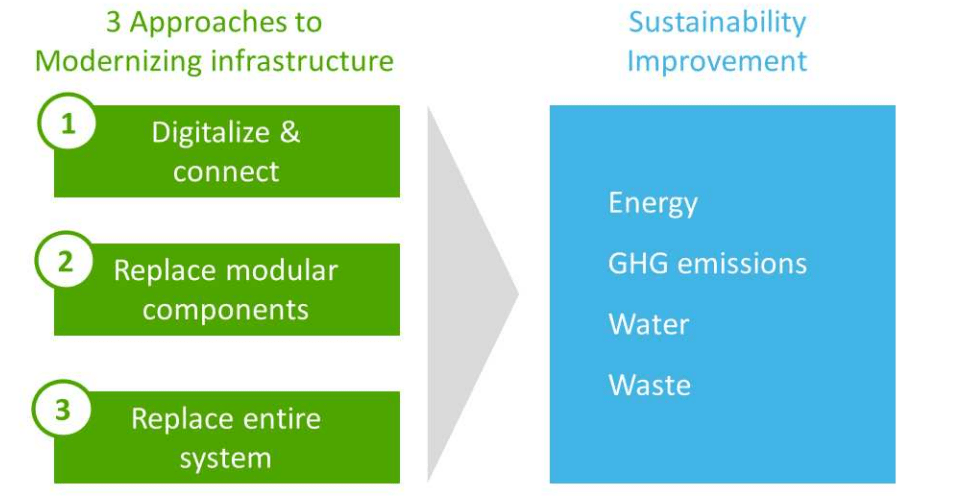
On average, data center IT equipment is replaced every four years, but the physical infrastructure systems that support them can last much longer.
Data centers are complex environments with a multitude of equipment involved. Although the physical infrastructure can outlast the IT equipment it supports, it can create significant risk to operations if left for too long.
If you’re unsure about when to modernise your equipment, look for the following signs:
1. Spare parts are becoming difficult or expensive to obtain
2. Repairs are coming increasingly more frequent
3. Maintenance costs are rising
4. Infrastructure components are visibly deteriorating
5. Failure and downtime are becoming increasingly more of a risk
6. Failure or downtime has already begun
Aging infrastructure can also create problems with efficiency and sustainability. With many data centers creating targets for net-zero emissions or sustainability practices, infrastructure can prevent them from obtaining
Sustainability Improvement
The four main categories to improve your data center sustainability is through energy, Greenhouse gas (GHG) emissions, water, and waste.

Energy
Data centers consume significant amounts of energy to stay running, which means finding a way to ensure energy use is efficient should be a high priority. Many inefficient data centers waste too much energy on their physical infrastructure systems. You can measure the effectiveness of your energy with power usage effectiveness (PUE). A PUE of 2.0 means that for every watt of IT equipment, another watt is being used by the infrastructure. Ideally, you want to get your PUE as close to 1.0 as possible.
Most modern data centers are cable of achieving PUEs much lower than 1.5, showing the difference old infrastructure can make to your energy efficiency levels. When looking to improve the efficiency of your data center there are three main areas to focus on that could be increasing your losses and energy expenses.
- Inefficient Systems – When using older infrastructure in your data center, the equipment usually operates less efficiently as the technology isn’t as advanced as in newer models.
- Oversized Infrastructure – When it comes to efficiency, it is important to have your infrastructure be the right sized for the right system. Systems that operate at light loads will always be less efficient when running.
- Lack of Visibility – Newer technology has been released that allows you to actively monitor your systems. Older systems don’t provide this level of monitoring, meaning they can be operating in degraded states without your knowledge.
GHG Emissions
Carbon emissions (CO2), methane emissions (CH4), PFCs, HFCs, and other gases make up the Greenhouse gas (GHG) emissions. When operating with aging infrastructures, these emissions are commonly released into the atmosphere.
Water
Traditional methods of cooling within data centers used water-colled chillers that consumed a significantly high among of water each year to function. Aging data centers will often still be using this technology, going against pressure to minimize water usage within companies. Schneider Electric have created alternatives to these traditional technologies that significantly minimize the water consumption needed to function.
Waste
Throughout the lifecycle of a data center, they produce a significant amount of material waste. This can be in the form of raw material extraction, manufacturing processes, packaging materials, replacement parts, or when the product reaches its end of life. When your product reaches end of life you have four options on disposal:
- Re-manufactured – Restore the system to its original functionality
- Re-purposed – Create a new use for its parts
- Re-cycled – Take the raw materials and use them elsewhere
- Put in landfills
Three Approaches to Modernization
1. Digitalize & Connect
2. Replace Modular components
3. Replace the Entire System
Digitalize and connect your systems
Older infrastructure systems don’t have the same options of monitoring and management as the newer systems have. Without the newer technology available inspections of equipment is a manual role, with people having to visually look at the infrastructure to try to detect potential problems. This process would involve individuals walking around, looking at displays, periodically measuring the system with handheld sensors, and inspecting for any visible damage or deterioration. This limits the ability to find any potential indicators of trouble in the future and leaves room for human error. Without real-time monitoring visibility, it is very difficult to maximize the health, safety, and longevity of your data center systems.
If you want to improve the reliability and sustainability of your system, digitalization is the ideal way to go. What’s more digitalization and connecting your existing system also has sustainability benefits! The five main benefits include:
1. Benchmark and improve sustainability metrics
Starting with a baseline of where your data is currently performing against sustainability metrics shows you where you’re starting and how much you need to improve. This can help you create your sustainability goals, which you can then track against ongoing data over time. Using sensors within your data will allow you to extract data to be analyzed and provide you with insight to ensure you meet the targets set without your sustainability commitments.
2. Reduce energy & carbon impact when interacting with other systems
When you digitalize and connect your systems you can interact with systems like the utility grid or onsite renewable energy sources. With access to the energy sources available, you can use peak shaving or load shifting to actively minimize your GHG emissions. You can also monetize any onsite energy sources through these interactions.
3. Increase the useful life expectancy
With the use of real time monitoring and predictive analytics, you can potentially identify problems before they create any serious problems. The increased likeliness of identifying problems early allows you to correct these problems early, prolonging the life, and improving the reliability, of your system. Prolonging the useful life of your system allows you to utilize your equipment for longer periods before needing to consider replacing it, improving the overall environmental impact of the data center’s lifecycle.
4. Avoid frequent generator usage
Using proactive monitoring and predictive analytics to identify and correct potential problems increases your system’s downtime. This reduces your reliance on using generator power and therefore reduces the amount of GHG emissions released through use of the generator.
5. Minimize service visits
When you connect your systems, you can manage them all remotely. This minimizes the need for onsite service intervention as management can be done from a separate location.
Replace Modular Components
Some data center systems are modular by design, allowing you to easily replace modular components to modernize your systems. Modular components are able to be easily swapped out without disruption when they become too old or obsolete. This is also a far most cost-effective way to continuously modernize your data center in comparison to replacing the entire system.
Replacing modular components also includes environmental benefits alongside being easier and cheaper to implement.
- Process fewer primary resources during manufacturing – Only needing to replace certain components at one time allows you to keep other components in use, allowing for less equipment needing to be manufactured. Being able to only replace the components in need of replacing means fewer raw materials, or ‘primary resources’, needed over the lifecycle of the data center.
- Process fewer waste materials – By only replacing the necessary modular components at one time, you can significantly cut back on waste as the majority of the data center modules can continue to run as normal.
- Leverage new digitalized and connected technologies – The modules available today are equipped with all the latest technology to improve the way your data center runs. With sensors and software incorporates into new modules, you can reduce resiliency risks and enable digital services to help your data center function to its full potential.
- Leverage smaller, lighter, and more efficient new technology – Newer designs of components use advanced technologies to allow for more efficient energy and water use. They are often smaller and lighter too which improves sustainability levels through using less raw materials and having a lower transportation impact.
- Minimize the environmental risk of toxic substances – Toxic substances are often linked with higher global warming potential. When modernising your data center, it’s important to dispose of and recycle any potentially hazardous products properly to minimize the environmental impact they have at end-of-life.
Replace the Entire System
The third, and most comprehensive, way to modernize your data center is to replace entire aging or obsolete systems at once. Whilst the initial cost of this option is the highest, the upfront cost will quickly be offset by the lower operational costs. This approach is best to use if:
1. Your system isn’t modular
2. Modular parts are no longer available
3. Maintaining your system is becoming continuously
4. If your system needs have changed
5. Advancements in technology and architectures warrant a full replacement.
Key environmental benefits also included in the replacement of modular components option include those associated with digitalized and connected components, smaller and lighter systems, and the elimination of environmental risks of toxic substances. Alongside this, this approach also offers the following sustainability benefits too:
- Rightsizing systems to improve energy efficiency – Systems that run close to or at their designed capacity are more effective than those that right lightly loaded. Ensuring your systems, like your UPSs, run at the right size for their needs will improve your overall efficiency levels, which will also directly impact your energy and carbon footprint.
- Newer technology improves energy use – The new technology that is included with newer systems are far more energy efficient than their older counterparts. These new advanced technologies can include more efficient modes of operation to help you reduce your energy use. They are usually designed with the circular economy in mind too, which improved the life expectancy, recyclability of the product, and the overall levels of sustainability of the product.
- Reduce maintenance needs – New systems have very little need for any maintenance to be undertaken within their first few years. This results in fewer service visits, reducing the environmental impact caused by transport and spare parts.
- Provides environmental performance visibility – To provide environmental transparency on products, most vendors will provide environmental profiles (PEP), environmental product declarations (EPD), or life cycle assessments (LCA) on their products.
Choosing the Right Approach
Every site will have different priorities, performance needs, and requirements. When choosing the right modernization approach for you, it is important to think about what is most important to your site and choose the best fit for your needs. To help you find the best approach, consider these 7 key factors to help guide you:
1. Prioritized sustainability metrics
Align your sustainability risks and priorities to help guide you to the right approach. For example, if you’re in a water-scarce location, water conversion may be your priority. Energy savings and the associated CO2 footprint may be more important to your operations in comparison to material waste. Figure out what is most important to your business and work around it.
2. Budget
For every project, there will be a budget. When making your decision on which approach to use, it is important to consider the total cost of ownership (TCO) and both the capital and operational expenses. Evaluate what your budget is before creating a plan so you can prioritize the most important aspects of your modernisation project.
3. Maintaining the system cost effectively
When systems begin to reach the end of their useful life, you will notice an increased rate of component failures and need for maintenance. As the system ages, finding spare parts will also become increasingly more challenging and expensive. If your current system is no longer supported by the vendor, replacing the entire thing maybe your easiest option.
4. System technology
Technology is constantly evolving, with many newer technologies proving to need few fewer resources to function. Depending on how old you current system is, you may want to heavily consider updating components or even the entire system. When considering these options, ask yourself:
- If replaced, would the new technology provide a better outcome?
- How much will your efficiency improve?
- Do they use less environmentally harmful materials?
- Will this enable further environmental benefits through interacting with other systems?
5. Data center location
The location of your data center can have a huge impact on your sustainability. The climate and electricity sources may impact your personal needs. With some locations, you may even have access to local government incentive programs to help minimize your personal cost of modernizing your data center.
6. Performance gaps
It is important to have an understanding of how your business needs have evolved. Is your current infrastructure oversized or undersized? Does it have sufficient runtime? Is it reliable? Do any of your current systems violate new codes or regulations? Think about what your business needs now, and ensure to match these needs when going forward.
7. Business disruption
Each potential approach will have very different disruption levels of the daily operations of your data center. Think about how much disruption your business could withstand. Once you’ve figured this out, think about how long it could withstand these levels. Take this into account when choosing your method.
Modernizing your data center can be a daunting task. It is a big project to undertake so you’ll want to make sure you find the right approach to put you on the right track. When looking to modernise, check out our products by Schneider Electic for a wide range of modern, efficient devices to improve your data center! If you want any further help or advice with anything mentioned please give our sales team a call on 0800 488 0000.

For additional help or support with anything mentioned in this blog, or any other products that we stock, don’t hesitate to contact our team! Use our contact form to get in touch and our team will get back to you quickly with our expert knowledge!
This is just a brief look at the APC Range, if you require more Schneider Electric equipment for your business, you can check our Schneider Electric microsite for a wide range of APC products to suit your needs.
Other Schneider Electric products Available from Comms Express:
Server Racks & Accessories | NetBotz Security and Environmental Monitoring | Extended Warranty | Accessory Extended Warranty | Power Distribution Units | Uniterruptible Power Supply
If you require any further information on these or any other products that we stock here at Comms Express, please do not hesitate to contact our team who will be only too happy to help.
Until next time…
